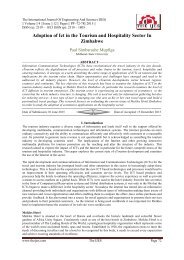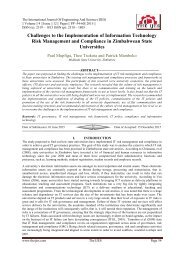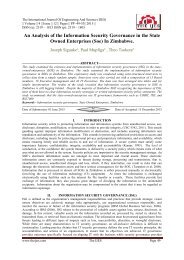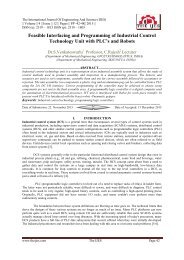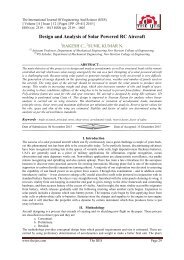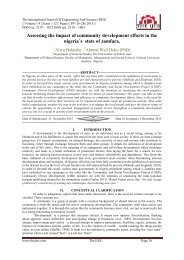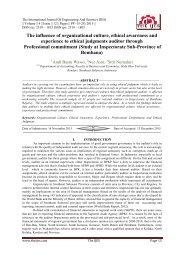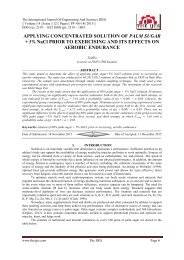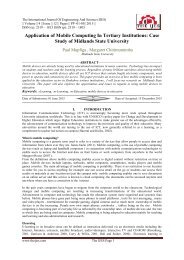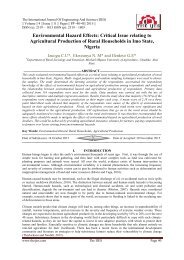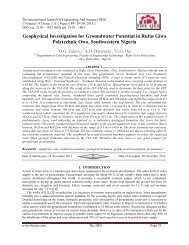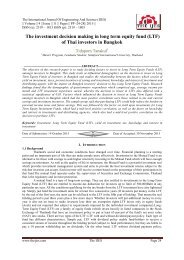The International Journal of Engineering and Science (The IJES)
The International Journal of Engineering
The International Journal of Engineering
Create successful ePaper yourself
Turn your PDF publications into a flip-book with our unique Google optimized e-Paper software.
Effect Of Some Botanical Extracts…<br />
It is very difficult to control even by the use <strong>of</strong> chemical fungicide. Moreover, most <strong>of</strong> the chemicals<br />
are costly so the farmers have to spend a large amount <strong>of</strong> money to buy these chemicals. Now-a-days use <strong>of</strong><br />
chemical for management <strong>of</strong> crop disease is being discouraged due to health hazards <strong>and</strong> environmental<br />
pollution. So, control <strong>of</strong> the pathogen through botanical pesticides or plant extracts <strong>and</strong> natural biocides might<br />
be a good alternative. Botanical extracts are biodegradable (Devlin <strong>and</strong> Zettel, 1999) <strong>and</strong> their use in crop<br />
protection is a practical sustainable alternative. It reduces environmental contamination <strong>and</strong> health hazards<br />
(Grange <strong>and</strong> Ahmed, 1988). Research on the active ingredients, fungicide preparation, application rates <strong>and</strong><br />
environmental impact <strong>of</strong> botanical fungicides is a prerequisite (Buss <strong>and</strong> Park, 2002) for sustainable agriculture.<br />
Botanical fungicides are unique because they can be produced easily by the farmers <strong>and</strong> small industries (Roy et<br />
al., 2005). Few works have been done by using tobacco, neem, garlic <strong>and</strong> some other plant extracts to control<br />
some other fungi. Different natural biocides also used separately or in combination with plant extracts to control<br />
some other fungi by the farmers. Antifungal activities <strong>of</strong> garlic, neem, allam<strong>and</strong>a have been reported by many<br />
researchers (Islam, 2005; Rahman et al., 1999; Arun et al., 1995 <strong>and</strong> Mohanty et al., 1995).It is thus dire<br />
necessity to work extensively to examine the effect <strong>of</strong> different concentration <strong>of</strong> tobacco, neem, garlic <strong>and</strong> other<br />
indigenous plant extract <strong>and</strong> natural biocides like ginger, turmeric, cow’s urine etc. in controlling disease which<br />
are easily available. <strong>The</strong>se botanical pesticides are affordable by low income farmers <strong>and</strong> they have the<br />
potentiality for use in agriculture, especially with the dramatic increase towards the consumption <strong>of</strong> organically<br />
produced plants <strong>and</strong> ensure the sound ecology <strong>and</strong> friendly environment without any pollution. So, the present<br />
experiment was undertaken to study the effect <strong>of</strong> some botanical extracts in water <strong>and</strong> cow’s urine <strong>and</strong> cow’s<br />
urine alone on the growth <strong>and</strong> sclerotia formation <strong>of</strong> S. rolfsii in vitro.<br />
II. MATERIALS AND METHOD<br />
<strong>The</strong> experiment was conducted in the plant protection laboratory <strong>of</strong> Agrotechnology Discipline, Khulna<br />
University, Khulna to evaluate the effect <strong>of</strong> different botanical extracts namely rhizome <strong>of</strong> turmeric, rhizome <strong>of</strong><br />
ginger, neem leaf, tobacco leaf in water (soaked tobacco leaf in water for 24 hours), tobacco leaf in cow’s urine<br />
(soaked tobacco leaf in cows urine for24 hours), <strong>and</strong> cows urine at different concentrations (30%, 40%, 50%,<br />
60%, <strong>and</strong> 70%) on the growth <strong>and</strong> sclerotia formation <strong>of</strong> S. rolfsii, causal agent foot <strong>and</strong> root rot disease <strong>of</strong> betel<br />
vine. In this experiment the crude extracts <strong>of</strong> the above indigenous plants <strong>and</strong> cows urine along with the crude<br />
extract <strong>of</strong> the selected indigenous plants extract were mixed with Potato Dextrose Agar (PDA) medium at<br />
different concentrations <strong>and</strong> the fungal mycelia were inoculated here to grow. <strong>The</strong> p H <strong>of</strong> the medium was<br />
adjusted to 6.5 by using p H meter with the help <strong>of</strong> 1N HCl or 1N NaOH. Data on the radial growth <strong>and</strong> number<br />
<strong>of</strong> sclerotia were recorded from there. <strong>The</strong> fungus S. rolfsii was collected from fungal isolates preserved in the<br />
plant protection laboratory <strong>of</strong> Agrotechnology Discipline, Khulna University. Botanical extracts were prepared<br />
by using a newly adapted method following the st<strong>and</strong>ard procedure (Vijayalakshmi et al., 1999). Following<br />
materials were required for the preparation <strong>of</strong> botanical extracts- tobacco leaves, neem leaves, rhizome <strong>of</strong><br />
turmeric, rhizome <strong>of</strong> ginger, <strong>and</strong> cows urine, conical flask, beaker, soap, detergent, water, glass beaker,<br />
measuring cylinder, blender, grinding stone <strong>and</strong> h<strong>and</strong> sprayer.<strong>The</strong> basic PDA medium was modified by using<br />
the crude extracts <strong>and</strong> natural biocides <strong>of</strong> turmeric, ginger, neem, tobacco leaves in water, tobacco leaves in<br />
cow’s urine <strong>and</strong> cow’s urine at specified concentrations. <strong>The</strong> p H <strong>of</strong> the medium was adjusted to 6.5. <strong>The</strong> plates<br />
were inoculated 5mm discs <strong>of</strong> 36 hours old PDA culture <strong>and</strong> the plates were incubated at 26±2 0 C. <strong>The</strong> radial<br />
growths <strong>of</strong> mycelium <strong>and</strong> colony characters in each plate were recorded after 60 hours <strong>of</strong> incubation. After 60<br />
hours <strong>of</strong> incubation, radial growth (cm) <strong>of</strong> S. rolfsii in petridishes was recorded. <strong>The</strong> radial growth (cm) <strong>of</strong><br />
mycelium <strong>of</strong> each plate was measured by taking average <strong>of</strong> the two diameters taken right angles for each colony<br />
<strong>and</strong> then these plates were kept for 30 days for sclerotia formation.<br />
Percentage inhibition <strong>of</strong> growth was calculated using the following formula:<br />
x-y<br />
% Inhibition = X 100<br />
X<br />
Where, x = Average growth (cm) <strong>of</strong> S. rolfsii in control petridishes.<br />
y= Average growth (cm) <strong>of</strong> S. rolfsii in each plant extract <strong>and</strong> biocides treated petridishes.<br />
After 30 days the sclerotia <strong>of</strong> each petridish were separated by using camel hair brush <strong>and</strong> number <strong>of</strong> sclerotia <strong>of</strong><br />
each petridish was counted manually. Here a petridish was maintained as control to compare it with others.<br />
www.theijes.com <strong>The</strong> <strong>IJES</strong> Page 78



